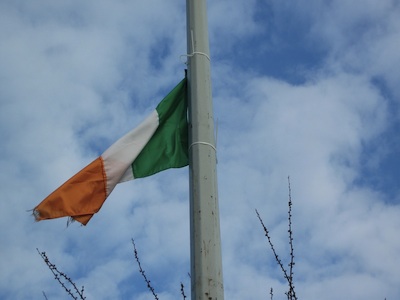
The Short Strand, a small working class nationalist and republican enclave of less than 3,000 men, women and children, has come under a renewed siege in the past week by violent loyalists.
The scenes have recalled some of the worst days of the conflict and have brought an international focus on recent events in east Belfast.
Although situated on the east bank of the River Lagan and completely dwarfed by its 60,000 strong unionist neighbours, who surround it on the other three sides, unionists and loyalists have always attempted to portray the minority community as the aggressors.
For a brief period on Saturday, there was hand-to-hand fighting as nationalist residents and home-owners bravely defended their district following a loyalist ‘protest’.
Rumours of ‘one last big riot’ planned by the unionist paramilitary UVF were borne out last Saturday, when elements of the PSNI appeared to be acting in support of a malign agenda. By mysteriously blocking the usual return route by protestors from the city centre, riot-ready loyalist youths were encouraged to return to east Belfast via the overwhelmingly nationalist Albertbridge Road, where trouble was guaranteed.
On Sunday, debris was still visible as Sinn Féin leader Gerry Adams walked around the Short Strand and spoke with residents whose homes were damaged.
He pointed out that it was the 15th time that an illegal loyalist procession had passed the neighbourhood since the flag protests began. He warned that someone could be killed if loyalist protests continued, and accused the PSNI of “facilitating” the illegal loyalist protests.
“The people of the Short Strand were let down by the PSNI and let’s be very clear about this, the people in the Short Strand would not have an awful lot of confidence in the PSNI to start with,” he said.
Despite his concerns, there were subsequent attacks on both Monday and Tuesday, with little protection from the PSNI.
A Catholic pensioner whose house was attacked by petrol-bombers has told how he fought the flames with a garden hose as bottles and paint bombs rained down.
Tommy McNulty’s Strand Walk home, which he shares with his 80-year-old wife Kathleen, was caught in a hail of petrol bombs, causing scorch damage and setting fire to the roof of a garden shed.
The retired dockworker said at least four or five petrol bombs had landed in the back garden of his two-storey home, near the loyalist Newtownards Road.
Bricks, broken bottles and paint bombs pelted his home and neighbouring homes.
Mr McNulty, who is forced to keep fire extinguishers in the garden in case of attack, used a garden hose to fight the flames on Monday night.
“We were sitting in the house and we heard the crash of the bottles and then we heard the war cry,” he said.
“We were attacked last Monday, Thursday and Friday by paint bombs and bottles as well as the latest incident.
“We were lucky last night was cold and damp which helped put the petrol bombs out and I was out with the hose as well while there was still stuff coming down.
“When something like that happens it is scary, especially when you are pensioners.
“When you see something like that you do panic.”
And on Tuesday, under cover of dark and away from the cameras, a masked loyalist mob attacked children and adults with Special Needs at St Matthew’s, the local parish church.
As petrol bombs, paint bombs and other missiles were landing within feet, the group was led away from St Matthew’s church by courageous workers.
Uneaten toast and tea abandoned by the children as they fled were still visible in the parochial hall the following morning.
Pilib O Ruanai said his Down’s Syndrome daughter and the others attending the Special Needs club had been badly distressed by the terrifying situation.
It was “a wee haven for them, some-where to go and meet their peers and it gives parents a bit of a break,” he said.
Parochial hall worker William Ward said when he arrived, over 100 loyalists were involved in the attack.
“We made a judgment it was time for the people to be taken away,” he said. “They were frightened and knew something was wrong and we tried not to exaggerate what was happening. They were just sitting there eating their tea and toast and then people came in to take them away.
“It upset them and frightened them and it frightened a lot of adults there as well.”
Des Dalton of Republican Sinn Féin said the continuing loyalist sectarian attacks on the people of the Short Strand illustrates the “unchanging reality” of life for large sections of the nationalist community in Belfast and throughout occupied Six Counties.
“Once again it is the nationalist people who must bear the brunt of loyalist mobs who have unleashed havoc in order to further the political agenda of the unionist political establishment.”
He said that the unionist establishment traditionally used armed loyalism “as a weapon in its arsenal”.
“The events in Belfast and other areas of the Six Counties over the past number of weeks underline the abnormality of the Six-County state. As Republican Sinn Féin warned in 1998, the Stormont Agreement has simply reinforced and institutionalised sectarianism in the Six Counties.
“Over the past 15 years it has served only to deepen the sectarian divide, thus condemning the people of the Six Counties to an ongoing cycle of sectarian conflict.
“This cycle of sectarianism can only be broken by the dismantling of the two partitionist states and the creation of a New Ireland.”
![[Irish Republican News]](https://republican-news.org/graphics/title_gifs/rn.gif)
![[Irish Republican News]](https://republican-news.org/graphics/title_gifs/harp.gif)

